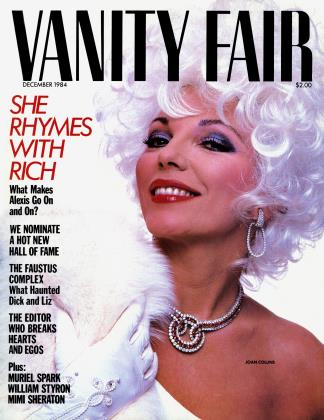Sign In to Your Account
Subscribers have complete access to the archive.
Sign In Not a Subscriber?Join NowVintage Point
The start of a bibulous new column
Vanities
I LIKE wine, all kinds of wine. Indeed, I love wine, from the plebeian jug wines of Gallo, Parducci, Pedroncelli, and Monterey Vineyard to the empyreal heights of Lafite, Romanee-Conti, Martha’s Vineyard, Bella Oaks, Chalone, Montrachet, Yquem, Dom Perignon, and Georges de Latour Private Reserve.
What continually astonishes me is the magnificent panoply of flavors, both within a single glass of wine and from one kind of wine to all others: the appley, lemony, buttery, nutty, grassy, toasty Chardonnays; the apricot, honeyed, citrus balance of the latest-harvest dessert wines; the delicate, floral, perfumed earlier-harvest German wines from the Mosel-Saar-Ruwer and Rheingau; the cascading plumminess of hoary port; the soft, lighter, velvety, richly scented Pinot Noirs of Burgundy and, now, occasionally, of California; and the majestic, awesome depth and complexity of what is for me the most exalted of all wines: the cabernet sauvignon, alone or in its Bordeaux or California blends with merlot and cabernet franc, embodying layer upon layer of the taste of black currants and other berries, of cassis, mint, cedar—all sharpened by acids and delineated by tannins from the grape skins and from the oak barrels in which it has been aged.
Few things please me more than to horrify supercilious waiters by ordering the “wrong” wine for my food. One can, mirabile dictu, pleasurably drink red wine with fish and white wine with meat without risking one’s reputation among knowledgeable imbibers. Of course, not all red wines can satisfactorily accompany all fish, but some can; it depends entirely on the character of the wine, the particular fish, and the way the fish has been prepared.
The only ironclad rule to go by is how the combination tastes. The more intense, pungent, or spicy the taste of a certain food, the more powerful, bigger, and more intense the wine must be. If you drink Chateau Lafite-Rothschild with chili, you’ll swear your wine merchant defrauded you. However, try Lafite again with a delicate roast of lamb and your anger will become a transport of delight. Conversely, the lighter and more delicate the flavors of what is to be eaten, the less obtrusive its accompanying wine must be for the food flavors to be savored, or indeed detected.
And, of course, one can select the food to fit the wine. Those of us whose first and strongest attraction is to wine frequently begin our meal-planning with a choice of wines. For example, you might start dinner with a delicately floral-scented Chardonnay, perhaps a Trefethen, Raymond, Grgich Hills, St. Clement, or Chalone, served with poached salmon, mousse of sole, or a mild vegetable cream soup. For the main course, the aforementioned Lafite, or one of the extraordinary cabernet sauvignons from California’s Napa Valley—such as Conn Creek, Stag’s Leap, Heitz Martha’s Vineyard or Bella Oaks, Joseph Phelps Insignia or Eisele Vineyard, or Beaulieu Vineyards Georges de Latour Private Reserve—would be shown to beautiful advantage by beef tenderloin or any nonpungent veal, lamb, or chicken preparation. If these wines outlast the food, they could be finished off with an assortment of cheeses. Sweet dessert wines, such as Chateau d’Yquem or other Sautemes or Barsacs, the German Trockenbeerenauslese wines, or the growing number of late-harvest Rieslings from California, can be accompanied by fruit, or souffles of fruit, or creme brulee.
Ultimately, each of us likes, or doesn’t like, a particular wine in exactly the same way that we like, or do not like, a work of music, poetry, painting, or sculpture. Ultimately, all that counts in wine is what does give us pleasure. Thinking will carry us to a certain point; beyond that it is all a question of personal taste, about which there can be no disputing, and for which, sometimes, there can be hardly any accounting.
Joel L. Fleishman
 View Full Issue
View Full Issue


















Subscribers have complete access to the archive.
Sign In Not a Subscriber?Join Now